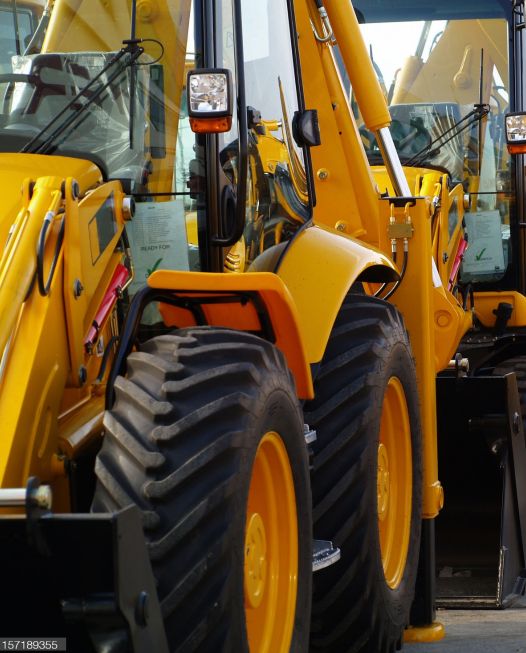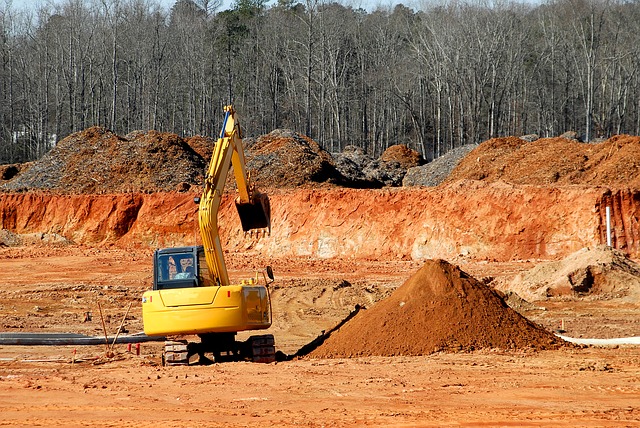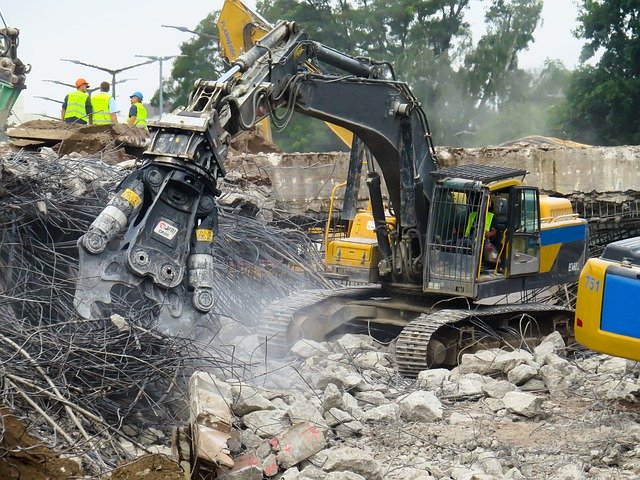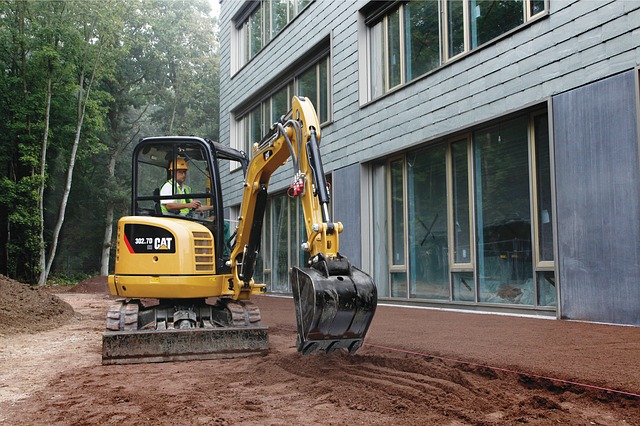
It doesn't matter if you are building a home or working on large-scale construction projects, it is important to hire an excavation contractor. A contractor should not only provide the correct equipment, but also clean up afterward. Click Here to know more about Septic Tank Installation
Excavators use various equipment and machinery such as an auger to dig holes and grading equipment to reshape the earth’s surface. They are typically powered by diesel engines but some newer models use electric motors. Besides flattening uneven soil and digging trenches, excavators can also be employed in landscaping projects such as grading the ground and creating drainage channels.
If you're considering new construction on your property, one of the first questions you should ask is "What excavating contractor installs?" You can expect a contractor to perform a few basic procedures, no matter what kind of project it is. These include foundation waterproofing or foundation installation, commercial digging, site preparation, demolition, or snow removal.
The main types of retaining walls are natural stone or artificial block retaining walls. Natural stone walls are made of soil and rocks, and can last for years. Artificial block retaining walls are made from concrete and can last for decades. They must be built level, straight, and tall to ensure stability.
Mini excavation is a specialized service that involves the use of small-scale equipment to dig, move, and remove soil. Excavation contractors are experienced in using mini excavators, skid steers, and other equipment for this type of work. Mini excavation services can be used for projects such as landscaping projects, trenching, and foundation work.
A college or trade school degree in heavy equipment operation is few, so most contractors will hire skilled operators or new operators and train them on-the-job. As with any industry, excavation contractors are made up of many different individuals with various backgrounds and experiences. Thus, a wide range of skills are required to work as an excavator.
Excavators are heavy construction equipment consisting of a boom, dipper (or stick), bucket and cab on a rotating platform known as the "house".[1] The house sits atop an undercarriage with tracks or wheels. They are a natural progression from the steam shovels and often mistakenly called power shovels, as power shovels may have similar looking buckets.[citation needed] All movement and functions of a hydraulic excavator are accomplished through the use of hydraulic fluid, with hydraulic cylinders and hydraulic motors.[2] Due to the linear actuation of hydraulic cylinders, their mode of operation is fundamentally different from cable-operated excavators which use winches and steel ropes to accomplish the movements.[3]
Retaining walls are relatively rigid walls used for supporting soil laterally so that it can be retained at different levels on the two sides. Retaining walls are structures designed to restrain soil to a slope that it would not naturally keep to (typically a steep, near-vertical or vertical slope). They are used to bound soils between two different elevations often in areas of terrain possessing undesirable slopes or in areas where the landscape needs to be shaped severely and engineered for more specific purposes like hillside farming or roadway overpasses. A retaining wall that retains soil on the backside and water on the frontside is called a seawall or a bulkhead.
Kelowna (/kəˈloʊnə/ (![]() listen) kə-LOH-nə) is a city on Okanagan Lake in the Okanagan Valley in the southern interior of British Columbia, Canada. It serves as the head office of the Regional District of Central Okanagan. The name Kelowna derives from the Okanagan word kiʔláwnaʔ, referring to a female grizzly bear.[8][9]
listen) kə-LOH-nə) is a city on Okanagan Lake in the Okanagan Valley in the southern interior of British Columbia, Canada. It serves as the head office of the Regional District of Central Okanagan. The name Kelowna derives from the Okanagan word kiʔláwnaʔ, referring to a female grizzly bear.[8][9]
Kelowna is the province's third-largest metropolitan area (after Vancouver and Victoria), while it is the seventh-largest city overall and the largest in the Interior.[10] It is the 20th-largest metropolitan area in Canada. The city proper encompasses 211.85 km2 (81.80 sq mi),[4] and the census metropolitan area 2,904.86 km2 (1,121.57 sq mi).[4] Kelowna's estimated population in 2020 is 222,748 in the metropolitan area and 142,146 in the city proper.[11] After many years of suburban expansion into the surrounding mountain slopes, the city council adopted a long-term plan intended to increase density instead - particularly in the downtown core. This has resulted in the construction of taller buildings, including One Water Street - a 36-story building that is the tallest in Kelowna.[12] Other highrise developments have already broken ground or been approved since then, including a 42-storey tower on Leon Avenue which will be the tallest building in the city, and among the tallest in B.C.[13]
Nearby communities include the City of West Kelowna (also referred to as Westbank and Westside) to the west, across Okanagan Lake; Lake Country and Vernon to the north; Peachland to the southwest; and Summerland and Penticton to the south.
The exact dates of first settlement in the Okanagan Valley are unknown, but a northern migration led to the habitation of this area some 9,000 years ago.[14] The Indigenous Syilx people are the first known inhabitants of the region, where they continue to live today.
In 1811, David Stuart travelled to the Okanagan Valley, becoming the first European to do so.[15] Despite this, it was not until 1859 that Father Pandosy, a French Roman Catholic Oblate missionary, became the first European to settle there. Pandosy's settlement was located at l'Anse au Sable (Bay of Sand), which he named in reference to the sandy shoreline. Although the population remained small for the rest of the 19th century, sustenance fruit growing expanded in Kelowna during the 1870s, and by the 1890s, commercial agriculture had become firmly established.[16]
Excavation
Contractor
Construction
Earthmoving
Digging
Site Preparation
Trenching
Demolition
Grading
Backhoe
Bulldozer
Heavy Equipment
Land Clearing
Underground Utilities
Soil Removal
Rock Excavation
Ditching
Landscaping
Foundation Work
Erosion Control
Compaction
Earthworks
Excavator
Shoring
Slope Stabilization
Road Construction
Pipeline Installation
Drainage
Land Development
Site Restoration
Environmental Remediation
Demolition Waste Management
Safety Protocols
OSHA Regulations
Excavation Permit
Underground Mapping
Dust Suppression
Trench Safety
Excavation Depth
Utility Location
Soil Analysis
Gravel Placement
Excavation Slopes
Excavation Support Systems
Hydro Excavation
Excavation Cost Estimation
Erosion Prevention Measures
Excavation Inspection
Silt Fencing
Grading Plans
If you are planning to hire an excavation contractor, you will need to find out if he or she is licensed. You should also check whether he or she is experienced. The best way to find an excavator is by interviewing several pros. Then, you can select the company that best suits your needs.
Yes, projects that require major excavation can be complex and require a lot of heavy machinery and a large crew. It's best to hire a general contractor to manage the excavation process for you, since excavating contractors typically subcontract as part of larger construction projects.
The excavated area is backfilled with soil to create a stable surface for the new foundation or basement. Afterward, landscaping services can be used to install drainage systems like French Drainage Systems, Trenches and Channels, Catch Basins and Storm Drains, and Yard Sloping.
Whether you are building a new home or repairing the one you already own, waterproofing the foundation is a must. Water can seep through the cracks in the concrete and cause damage. Waterproofing can also prevent water from escaping and flooding your basement.

As the excavation contractor, you are responsible for the installation of underground utilities such as sewer lines, water mains, and drainage systems. These lines help deliver essential utilities to your project site, but they must be handled carefully to prevent interfering with existing systems. This is because the lines are heavy and fragile, which can lead to costly damage during excavation.
Any unwanted objects should be removed during excavation. For instance, you need to get rid of stumps. Also, you might find large rocks or other stones that may block your installation route.
You should first determine how much snow falls on your property during winter. You will need the right equipment depending on how much snow you have. A snowplow is a good choice for large commercial properties. Clearing a lot snow and ice can be difficult with a shovel.
Test the soil is an additional element in site preparation. Test the soil to find out its properties. This includes density and tensile resistance. This allows you assess whether the ground is suitable to build on. You may need test the soil, depending on where it is located.
Site preparation is an essential part of the construction phase of a home. A number of steps are involved to optimize your construction job. You will have a much easier time and your new home will last longer if you prepare properly.
Before demolition, all utilities, including gas and electricity lines, should be disconnected. This is to prevent hazards and prevent the risk of injuries during the process. Click Here to know more about Septic Tank
Excavating is a dangerous activity. Proper engineering is crucial to ensure the safety of workers and passersby. Employing a skilled contractor will help prevent soil compaction. This will also ensure that landslides don't occur.
You will need more equipment if your project is larger. A tow-behind vehicle is necessary for removing concrete driveways.
An excavating contractor has the tools to build a more attractive terrain than a flat lawn. Flat lawns can be sloped to improve runoff control.

The best way for you to know what equipment is needed is to get a quote from the snow removal business. A majority of companies will give you a free quote prior to you making any commitments.
Septic tanks come in a variety of materials, including concrete, fiberglass plastic, steel, and plastic. Fiberglass tanks tend to be lighter and more cost-effective to install. They are also more likely to crack than concrete tanks.
You should design the membrane you use to waterproof a variety of substrates. It should be at least six inches from the foundation. It should be able extend at least 12 ins. into the walls intersecting it.
Using a snow contractor to remove snow from your yard is often the best and most cost-effective option. Snow removal companies tend to be booked during winter. You can get the best snow removal rates by calling them before the snowy season starts.
It doesn't matter if you have a driveway, patio, or sidewalk, removing concrete can be difficult. It is important to determine the dimensions of the slab and the reinforcements that it was constructed with. Also, consider the cost of removing the slab. After you have made your decision, you can either hire a contractor to do the job or you can do it yourself.
Contractors that provide trucking services may work with various materials, including sand and gravel, concrete, fill, and other construction materials. They may work on projects related to road construction or maintenance, or demolition work. They may also be involved in demolition projects or excavation work at a construction site. When working with dirt, excavation contractors must ensure that they are taking care of the health and safety of their employees as well as the surrounding environment.
A contractor who can help with demolition depends on the project's scale. Demolition involves complex processes that require permits, heavy equipment and safety measures.
The foundation of your new home is an important part of site prep. This can be done either by excavating the site or leveling it.
Another part of site preparation is to create a solid foundation for your new home. This can be done by leveling the land and excavating.
A rigid insulation board or a sheet membrane is the most common type of waterproofing. The membrane is then installed over the foundation walls. The membrane is then secured using anchors.

You need to dig at least six inches of trench in order to create a sloped trench. This will allow for friction losses caused by moving water.
A trenching machine is needed to dig the trench. You can either buy one or rent one per day. It will vary in cost depending on the region. A competent trencher is capable of handling a 10" or 12” wide trenching cable.
There are many methods to remove concrete. But the best choice for your situation will be based on your requirements. This depends on how big the project is and how large the concrete. If you only want to remove a small chunk of concrete, you will only require a few tools such as a jackhammer, and a wheelbarrow.
Demolition companies should have the ability to provide safety measures as well as a detailed demolition program. Demolition experts can provide an accurate timeline for the project.
French drains can help protect basement from flooding. The drain will last decades if installed properly. You should be aware of several things before you install the drain.
This can also include excavation and test drilling to make sure your building has the best foundation.

An Excavating Contractor is a professional service provider specializing in excavation and earth-moving tasks for construction, landscaping, and various other projects. These contractors are equipped with heavy machinery and skilled operators to carry out excavation, grading, trenching, and site preparation works. They play a crucial role in the initial stages of construction and development projects, ensuring the proper groundwork is laid for a successful and safe construction process.
Excavating Contractors offer a wide range of services related to earth-moving, site preparation, and land development. Some of the primary services they provide include:
Excavation: They are responsible for digging and removing earth to create a level and stable foundation for construction projects. This includes excavating basements, trenches, and other spaces required for various structures.
Grading: Excavating contractors perform grading to ensure the land is level and properly sloped, preventing issues like water accumulation and erosion. Proper grading is crucial for site drainage and stability.
Trenching: They specialize in creating trenches for utility lines, such as water pipes, sewer lines, electrical cables, and communication lines. Trenches are essential for safely housing these vital infrastructure components.
Land Clearing: Excavating contractors can clear vegetation, debris, and rocks from the construction site to prepare it for building. This includes tree removal, stump grinding, and clearing any obstacles that may hinder construction.
Landscaping Preparation: They prepare the land for landscaping projects by shaping the terrain, creating berms, and establishing proper drainage systems to ensure the success of the landscaping work.
Important information:
Hiring the right excavating contractor is essential for the success of your project. Here are some crucial factors to consider:
Experience and Reputation: Look for contractors with extensive experience in the industry and a positive reputation. Check reviews, ask for references, and inquire about their past projects to assess their track record.
Licenses and Insurance: Ensure that the excavating contractor holds the necessary licenses and permits required to operate in your area. Additionally, they should have liability insurance to cover any potential damages or accidents during the project.
Equipment and Technology: Verify that the contractor has modern and well-maintained equipment. Advanced machinery and technology can improve the efficiency and precision of the excavation work.
Safety Measures: Safety should be a top priority for any excavation project. Inquire about the contractor's safety protocols, training procedures, and compliance with safety regulations.
Cost and Quotes: Obtain detailed quotes from multiple excavating contractors for a clear understanding of the project's cost. However, avoid choosing solely based on the lowest price, as quality and reliability are equally important.
Important information:
Retaining walls are necessary when there is a significant change in elevation on a property or site. They are primarily used in the following situations: 1. To prevent soil erosion and the collapse of sloped areas. 2. To create terraced landscapes, allowing for more usable space on a hilly property. 3. To protect structures like buildings, roads, or utilities from the pressure of soil or water.
Key information:
There are several types of retaining walls, each with its unique construction methods and purposes. The main types include: 1. Gravity retaining walls: These rely on their weight and mass to resist pressure from the retained soil. 2. Cantilever retaining walls: They have a thinner stem and a base slab, which acts as a lever to resist soil pressure. 3. Sheet pile retaining walls: These walls use interlocking steel, vinyl, or wood sheets to hold back the soil. 4. Anchored retaining walls: They include additional support using cables or other anchors to reinforce the wall. 5. Gabion retaining walls: These are constructed using wire cages filled with rocks or other materials.
Key information:
<h2>How to design a retaining wall? </h2> Designing a retaining wall requires careful planning and consideration of various factors. Here are the essential steps: 1. Conduct a site assessment to understand soil characteristics, water drainage, and the extent of the slope. 2. Determine the height and length of the wall based on the site's requirements and load-bearing capacity. 3. Choose the appropriate type of retaining wall based on the site assessment and aesthetic preferences. 4. Calculate the pressure exerted by the soil to select suitable materials and reinforcements. 5. Consider drainage options to prevent water buildup behind the wall, which can weaken its stability.
Key information:
Retaining walls are necessary when there is a significant change in elevation on a property or site. They are primarily used in the following situations: 1. To prevent soil erosion and the collapse of sloped areas. 2. To create terraced landscapes, allowing for more usable space on a hilly property. 3. To protect structures like buildings, roads, or utilities from the pressure of soil or water.
Key information:
There are several types of retaining walls, each with its unique construction methods and purposes. The main types include: 1. Gravity retaining walls: These rely on their weight and mass to resist pressure from the retained soil. 2. Cantilever retaining walls: They have a thinner stem and a base slab, which acts as a lever to resist soil pressure. 3. Sheet pile retaining walls: These walls use interlocking steel, vinyl, or wood sheets to hold back the soil. 4. Anchored retaining walls: They include additional support using cables or other anchors to reinforce the wall. 5. Gabion retaining walls: These are constructed using wire cages filled with rocks or other materials.
Key information:
re are the essential steps: 1. Conduct a site assessment to understand soil characteristics, water drainage, and the extent of the slope. 2. Determine the height and length of the wall based on the site's requirements and load-bearing capacity. 3. Choose the appropriate type of retaining wall based on the site assessment and aesthetic preferences. 4. Calculate the pressure exerted by the soil to select suitable materials and reinforcements. 5. Consider drainage options to prevent water buildup behind the wall, which can weaken its stability.
Key information:
Are there any legal or permit requirements for building a retaining wall? < The legal and permit requirements for building a retaining wall vary depending on the location, local building codes, and the height of the wall. In many jurisdictions, you may need to adhere to the following guidelines: 1. Obtain necessary permits: Some areas require obtaining permits before constructing a retaining wall, especially if it exceeds a certain height. 2. Comply with property line regulations: Ensure that the wall's construction does not encroach on neighboring properties. 3. Follow engineering standards: If the wall is of substantial height, it may need to be designed and certified by a licensed engineer. 4. Environmentally sensitive areas: Special regulations may apply if the site is close to water bodies or environmentally protected zones.